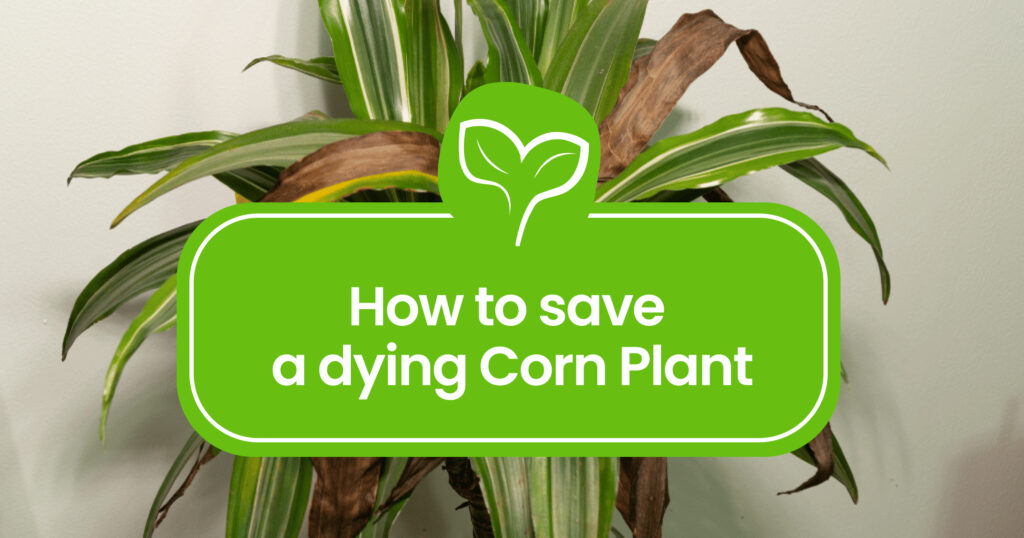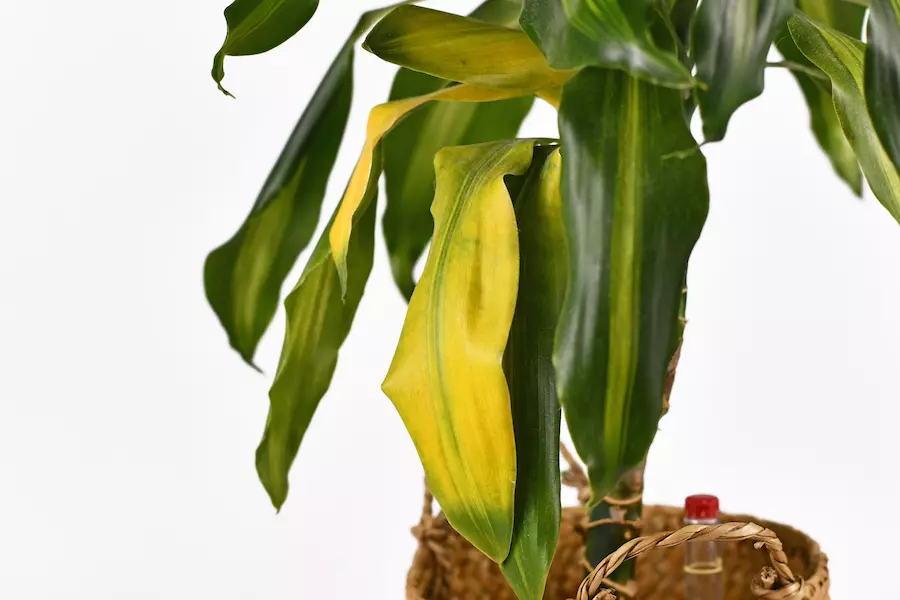
Dracaena fragrans, also known as Corn plant, is a popular indoor houseplant among beginner gardeners. Its popularity comes from the fact that it requires very little care, yet its beautiful greenish leaves can decorate your home.
Obviously, you want to keep your plant healthy and happy, so there are some signs you need to keep an eye out for. For example, If the leaf tips start to turn brown or you start to see faded colors on them, that is a sign of over-watering, underwatering, or rotting roots. The solutions also vary depending on the signs, for example, if the leaves are brown you can just cut them off. In colder environments, it might be enough to just move them to a warmer place.
In this article, we’re gonna assist you in checking out the plant and figuring out if there’s any disease going on. After that, we’ll show you how to tackle different diseases step by step. Let’s see, how to save and revive your dying Corn Plant!
What are the signs of a dying corn plant?
You can totally spot when the corn plant is feeling down just by looking – whether it’s the leaves, the whole deal, or even the roots. Figuring out what’s up is key to knowing what to do next. Here’s a rundown of the usual red flags for a struggling plant.
- Brown stems: You can easily see those brown stems on the plant. It’s interesting how sometimes the lower bit of the plant is all good, but the upper part goes brown. That’s a sign that the stems are getting sick in that upper area.
- Yellow leaves with brown leaf tips: Yellow leaves are like the top clue that something’s off with a sick corn plant. They could also point to root rot. What matters is figuring out if it’s just the tips or if the entire leaves are turning brown or kinda brownish-green. That’s the key distinction to keep an eye on.
- Root rot: Roots going all mushy isn’t exactly a surefire sign that the plant’s sick. It’s more like a sign that it’s getting too much water. But, those soggy roots can lead to leaves going brown and the soil getting all wet and smelly.
- Pests: When creepy crawlies (pests) start showing up on the plant, it’s like an infestation alert. You’ll mostly spot these hanging out on the big, lush green leaves.
- White powder on leafs: The leaves have a white powdery substance. It is a fungus called Powdery mildew. This type of fungus likes damp environments and usually “attacks” plants planted outside by the wind.

Why does my corn plant’s leaves turn yellow then brown?
The leaves of the corn plant turn yellow, then brown due to inadequate watering. In the process, the leaf itself turns yellow first, then the leaf tip turns brown. Then the whole leaf turns brown, which means that the life disappears from the leaf. Another problem is that it is underwatered. Other signs of this include a leaf that is bent back or a dry soil surface.
Another problem is excessive direct sunlight. The leaves of the corn plant will burn, causing the leaves to turn yellowish and then brown. This increases the plant’s need for water, which, if left unchecked, will have a serious effect on the whole plant.
Overfertilisation triggers such effects in the leaves. Too much fertiliser means that the plant will not be able to handle the vitamins and nutrients in the fertiliser and will excrete them. A white crust of salt can then be seen on the surface of the soil.
How to make the right environment for corn plants?
Creating the right environment for your plants is super important if you want them to keep growing. But, you gotta get the lowdown on the particular environmental stuff that matters for corn plants.
What soil does the corn plant need?
These plants thrive in loose and loamy soil. The roots need to be protected from being constantly in water, so the soil must be well drained. You can use a pre-made dracaena soil mix that ensures it drains away the excess water and does not contain additives.
How much water does the corn plant need?
You don’t want the soil to turn into a desert, but drowning it isn’t great either. Finding that sweet spot between not letting it dry out completely and not soaking it too much is key. Too much water can lead to root rot, so it’s a balancing act. Water the plant until the soil is visibly damp. Severely wilting corn plant can be also cured easily by watering it more.
How often should you water the corn plant?
On average, you should water every 10 days. You can tell with a trick: Stick your finger in the soil about 2 inches and if you don’t feel the soil is wet, water. Again, make sure that your soil is dry enough.
How much sun does the corn plant need?
The corn plant isn’t a big fan of basking in full sun, so it’s all about that indirect light vibe. Pop it in a cozy corner of the room where it can catch some nice, gentle light. Too much direct sunlight can actually scorch those leaves, so let’s avoid that.
What are the temperature and humidity conditions for the Dracaena fragrant?
Dracaena fragrant is a fan of spots with a bit of moisture and craves that humid air. If the air is too dry, it can make your corn plant sick. Aim for a humidity sweet spot between 40 and 50 percent. And as for the temperature, it’s all about indoor comfort, ideally hanging out between 59°F (15°C) and 75.2°F (24°C).
How to save a corn plant from dying?
Once we’ve got the hang of spotting the illness signs and nailing down the good environmental stuff, it’s time to dive into the actual rescue mission. When it comes to pests, you can bring out the chemical big guns, but for issues like overwatering, underwatering, and leaf burns, it’s all about going the organic route to sort things out.
How to revive a dying corn plant?
Keep the essential environment condition for the plant everytime to ensure the success of revive. These are the steps of reviving your corn plant:
- Repot your corn plant: Repotting means you are giving a new place for living with fresh soil mix. Use a high-quality indoor plant potting mix.
- Adjust watering and soil conditions: If too wet, water less often, if too dry, water the plant. From the plant’s soil you can determine the moisture with the finger method.
- Provide indirect light and adequate temperature: Keep the temperature at a comfortable temperature, such as room temperature, which is enough for the given temperature range and avoid placing it in the full sun.
- Prune the dead parts: Cut off leaves that have already turned brown to prevent further browning of the plant.
- Manage pests and desease: Wipe down the leaves with a damp cloth to remove insects and pests from the unseen places.
- Feed your plant: Provide your plant a nutrient boost with an appropriate fertilizer. Keep in mind that amount you are going to add to your plant as you don’t want to overfertilize the soil. It can lead to death of the corn plant as it was described earlier.
How to save a dying corn plant damaged by pests and disease?
Pests tend to cause problems when the plant gets too much water. Overwatering leads to root rot and a bacteria party on those roots, which really doesn’t help the plant’s chances of doing well. When roots are soaking, bacteria sets up shop because they’re all about that damp scene.
The best solution is to let the soil dry out. If the rot has already caused some serious damage, consider giving your plant a fresh start by moving it to a new pot with dry soil. This can help things pick up speed since the roots won’t be sitting in water for as long, and it reduces the odds of bacteria.
These are the most common pests of Corn Plants:
- Thrips
- Mealybugs
- Spider mites

Gardening experts suggest neem oil as a natural fungicide that can wrangle those pests. And if you’re dealing with bugs, you can grab some isopropyl (you might know it as rubbing alcohol) and drop it onto a cloth to give those plant leaves a disinfecting wipe-down.
Leaf spot is like the usual suspect when it comes to dracaena plants getting sick. It shows up as those brown spots on the leaves and often happens because the soil’s been too soggy. To keep it at bay, try cutting back on the watering routine.
How to save a dying corn plant covered by powdery mildew?
To save your corn plant covered by powdery mildew you need to cut the infected leafs. It is necessary to control the spread of the fungus, which is why cutting is necessary. Powdery mildew prefers moist environments and occurs in the spring when temperature is between 68°F and 78°F (20°C and 25°C). It is typically found in the spring, when humidity rises in the evening and the fungus thrives during the day in good weather. As the summer comes, this fungus disappears because the high humidity disappears due to the higher daily average temperature.
Use an organic fungicide to prevent powdery mildew. Without a protectant, avoid late watering. As written, humidity increases in the evening. Do not help the fungus.
How to save your dying corn plant by propagating it?
Dracaena plants can be saved by propagation. The propagation technique you can use is division. Look for a part of the plant that is still healthy. The key is to separate the healthy, strong part from the dying part.
To tackle this, you’ll need to take the plant out of its pot, which makes it easier to do some investigating. Grab a pair of sterilized scissors and snip right at the spot where the roots connect, effectively separating the plant into distinct parts.
Afterward, plant the healthy cutting in fresh soil in a new pot. By doing this, you’re actually kickstarting the process of propagating a fresh corn plant, essentially rescuing the ailing one.
How to prevent corn plants from dying?
To keep plant diseases and deaths in check, it’s crucial to keep an eye on those conditions we talked about earlier. Plus, by consistently keeping tabs and watching out, we can catch the illness source early and jump in pronto to prevent any dire consequences.
Conclusion
Fortunately, corn plants are pretty easy to maintain, and also difficult to spoil completely. Still, just like any other plant, it needs a bit of TLC (Tender Loving Care). One of the top culprits for plant troubles is actually too much watering. When you overdo it, you might notice the leaf tips turning yellow – that’s a surefire sign. To fix this, give watering a break for a bit. And if things have gone too far, consider giving it a fresh start in new soil that’s dry, packed with nutrients, and ready to help the plant bounce back.